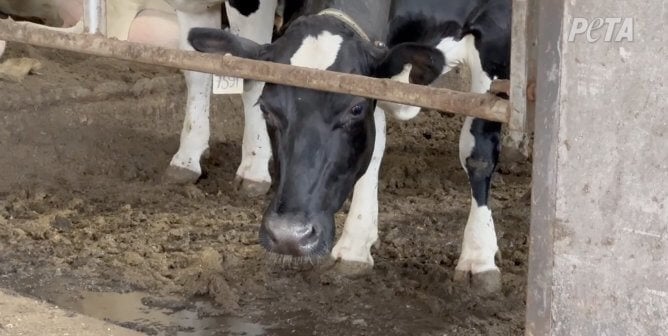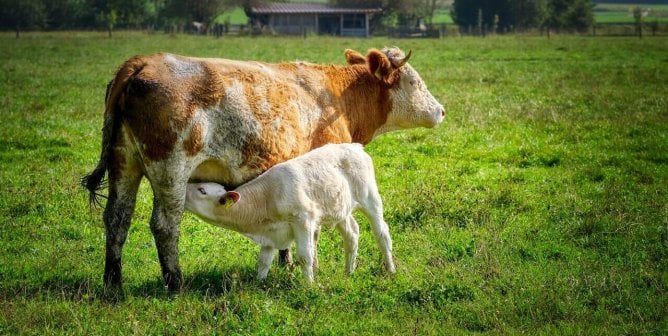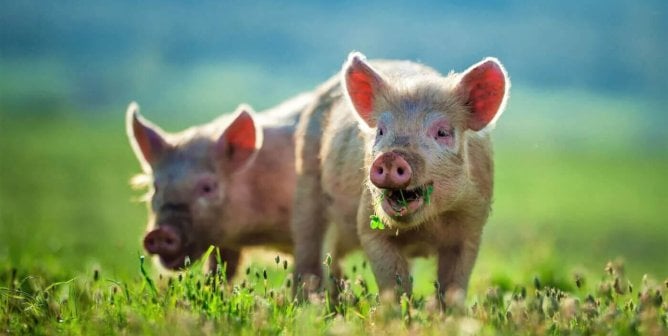Poultry and Eggs: Industries That Abuse Chickens
Chickens are inquisitive, intelligent animals who, according to animal behaviorist Dr. Chris Evans of Australia’s Macquarie University, “are good at solving problems.” He explains that chickens are able to understand that recently hidden objects still exist, a concept that small children are unable to master. Discussing chickens’ capabilities, he says, “As a trick at conferences, I sometimes list these attributes, without mentioning chickens, and people think I’m talking about monkeys.1
In nature, chickens form friendships and social hierarchies, recognize one another and develop a pecking order, love and care for their young, and enjoy dust-bathing, making nests, and roosting in trees. Chickens raised for meat and eggs are unable to engage in any of these activities.
Chickens Raised for Meat
Nearly 9 billion chickens are raised and killed for meat each year in the U.S.2 The industry refers to these chickens as “broilers” and raises them in huge, ammonia-filled, windowless sheds where artificial lighting is manipulated to make birds eat as often as possible.3
To keep up with demand and reduce production costs, genetic selection and a steady dose of growth-promoting drugs are used to ensure large, fast-growing birds. Today, most chicks take only six to seven weeks to reach “processing” weight, and chickens raised for meat weigh an average of one-fifth more than those raised in the 1950s.4 The shift in consumer habits—from eating whole chickens to chicken parts—has encouraged the industry to raise birds with “thicker breast[s], fatter wings and chubbier drumsticks,” according to the Associated Press.5 Skeletal problems, especially in the legs, are common among these birds, and many die from ascites, a disease thought to be caused by the inability of birds’ hearts and lungs to keep up with their rapid skeletal growth. According to one study, “[T]he bird’s demand for oxygen exceeds its cardiopulmonary capacity.”6,7
Chickens Raised for Their Eggs
About 376 million hens are raised for eggs in the U.S., and most spend their lives in battery cages, stacked tier upon tier in huge warehouses.8,9 Millions of day-old male chicks are killed (usually in a high-speed grinder called a “macerator”) every year because they are worthless to the egg industry.10 The wire mesh of the cages rubs off their feathers, chafes their skin, and causes their feet to become crippled.
Broken bones are also common among these birds, who “suffer significant osteoporosis,” according to the International Veterinary Information Service.11 A study published in Poultry Science explained that “high production hens’ structural bone is mobilized throughout the laying period in order to contribute to the formation of eggshell.”12
Although chickens can live for more than a decade, hens raised for their eggs are exhausted, and their egg production begins to wane when they are about 2 years old.13,14 When this happens, they are slaughtered. More than 100 million “spent” hens are killed in slaughterhouses every year.15 During a PETA investigation of an Oklahoma egg farm, an eyewitness saw 49 thousand of these unprofitable birds beaten and gassed to death in a single weekend.
Slaughter
The lives of chickens raised for meat and eggs end with a grueling trip to the slaughterhouse. Before the terrifying journey, chickens are caught by workers and placed into crates. One reporter at a Delmarva chicken farm described the “catching” process as “a half-dozen men … grabbing [chickens] by their feet, shoving them into the drawers of 6-foot-high crates. The men can catch more than 6,000 birds in an hour.”16 One industry study of catching practices concluded that “[t]he number of freshly broken bones found in live birds prior to slaughter and the number of old healed breaks found at slaughter are unacceptably high.”17
Once at the slaughterhouse, the birds are dumped from their crates and hung upside down in shackles, further injuring their legs, which are already tender and often broken. Their throats are cut open by machines, and they are immersed in scalding-hot water for feather removal. They are often conscious throughout the entire process. Because hens’ bones are so brittle from egg production that the electric current would cause them to shatter, hens often are not even stunned before their throats are cut.18
Antibiotics Lead to Drug-Resistant Bacteria, Human Illnesses
Factory farms simply cannot raise billions of animals per year without using drugs that allow the animals to survive cramped, filthy, and stressful conditions that would otherwise kill them. Millions of pounds of antibiotics are fed to chickens, who metabolize only about 20 percent of the drugs fed to them: The remaining 80 percent ends up in their feces.19 The 3 trillion pounds of waste produced by factory-farmed animals every year is usually used to fertilize crops and subsequently ends up leaching into waterways—along with the drugs and bacteria that it contains.20
Environmental and human health problems are developing as a result of this unchecked use of antibiotics. A U.S. geological study found 14 antibiotics used in animal agriculture and human medicine in almost 50 percent of the waterways tested.21
Arsenic-laced additives are mixed into the feed of about 70 percent of the chickens raised for food, but chickens do not eliminate all of it in their waste.22 Legal battles continue on behalf of more than 100 plaintiffs in an Arkansas town with the second-largest chicken population in the U.S. Residents there have been diagnosed with arsenic poisoning that has led to blood diseases and extremely rare types of cancer.23 The defendants are poultry producers who have been using an antibiotic (specifically, inorganic arsenic) in chicken feed that becomes toxic in litter, which was spread on nearby crops as fertilizer.24
One scientist examined poultry workers’ health and found that more than 40 percent of the test subjects were infected with campylobacter and that the bacteria was “supersized” and resistant to antibiotics. She remarked, “There have been a lot of stupid things we’ve done as a species … but this (giving animals antibiotics) has to be one of the most stupid.”25
Food-related illnesses affect more than 48 million people annually and kill more than 3,000.26 Consumer Reports found that more than half of chickens studied were infected with E. coli and almost half tested positive for at least one multidrug-resistant bacterium.27 Of the 65 billion eggs taken from chickens every year, more than 2 million are estimated to be contaminated with salmonella and, as the Centers for Disease Control and Prevention cautions, “One contaminated egg can contaminate an entire batch of pooled eggs. Everyone who eats eggs from that batch is at risk for illness.”28
In addition to their toxic effects on the human body, meat, eggs, and dairy “products” contain large amounts of harmful substances such as cholesterol and saturated fats. For example, one large egg contains more than 200 milligrams of cholesterol, and chicken contains the same amount of cholesterol as beef.29,30,31
What You Can Do
The best thing that you can do for chickens is to stop eating them and spread the word to your friends about the health, environmental, and animal welfare problems caused by raising chickens for food. Eat tofu scrambler instead of scrambled eggs, try egg replacer in your baked goods, and marinate tofu at your next barbecue.
References
1William Grimes, “If Chickens Are so Smart, Why Aren’t They Eating Us?” The New York Times, 12 Jan. 2003.
2 United States Department of Agriculture, “ Poultry – Production and Value 2017 Summary,” National Agricultural and Statistics Service, Apr. 2018.
3 Victor G. Stanley et al., “Relationship Between Age of Commercial Broiler Chickens and Response to Photostimulation,” Poultry Science 76 (1997): 306-310.
4 Cindy Skrzycki, “Old Rules on Poultry Categories May Fly the Coop,” The Washington Post, 7 Oct. 2003.
5 “As Demand Grows, So Do Chickens,” Associated Press, 2002.
6 Joy A. Mench and Paul B. Siegel, “Poultry,” South Dakota State University, College of Agriculture and Biological Sciences, 11 Jul. 2001.
7 J.M. Balog, “Effect of Dietary Aspirin on Ascites in Broilers Raised in a Hypobaric Chamber,” Poultry Science, 79 (2000): 1101-1105.
8United States Department of Agriculture, “Chicken and Eggs, 2017 Summary,” National Agricultural and Statistics Service, Sept. 2016.
9 Mench and Siegel.
10 “Group: Chicks Ground Up Alive at Hatchery,” Associated Press, 9 Sept. 2009.
11 M. Gentle, “Comparative Vertebrate Nociception and Pain,” Roslin Institute, Scotland, 3 Dec. 2002.
12 T.G. Knowles and L.J. Wilkins, “The Problem of Broken Bones During the Handling of Laying Hens—A Review,” Poultry Science 77 (1998): 1798-1802.
13 Molly Snyder Edler, “Chicken Love Leads to Book Deal,” OnMilwaukee.com, 26 Sep. 2002.
14 Ryan A. Meunier et al., “Commercial Egg Production and Processing,” Department of Curriculum and Instruction, Purdue University, 4 Apr. 2003.
15 Blake Morrison et al., “Old-hen Meat Fed to Pets and Schoolkids,” USA Today, 16 Dec. 2009.
16 Amy Ellis Nutt, “In Soil, Water, Food, Air,” Star-Ledger, 8 Dec. 2003.
17 Knowles and Wilkins.
18 Mench and Siegel.
19 Nutt.
20 Ibid.
21 Ibid.
22 Betty Hileman, “Arsenic in Chicken Production,” Chemical & Engineering News 85 (2007): 34-35.
23 Ron Wood, “Plaintiffs Drop Out of Lawsuit,” NWAonline.com, 11 Nov. 2009.
24 “Arsenic Allegations,” MeatNews.com, 16 Dec. 2003
25 Nutt.
26 Centers for Disease Control and Prevention, “Food Safety,” 29 Apr. 2024.
27 “Dangerous Contaminated Chicken, ” Consumer Reports, Jan 2014.
28 Centers for Disease Control and Prevention, National Center for Emerging and Zoonotic Infectious Diseases, “Salmonella serotype Enteritidis,” 23 Nov. 2010.
29 USDA National Nutrient Database for Standard Reference, “Egg, Whole, Raw, Fresh,” Dec. 2011.
30 USDA National Nutrient Database for Standard Reference, “Chicken, Broilers or Fryers, Meat and Skin, Raw,” Dec. 2011.
31 USDA National Nutrient Database for Standard Reference, “Beef, Carcass, Separable Lean and Fat, Select, Raw,” Dec. 2011.
32 Neal Ungerleider, “California’s New Egg Law,” KCET, 5 Jan. 2015.
33 Patrick McGreevy, “Live in California and Buy Eggs? If Voters Approve This in 2018, They’ll Need To Be from Cage-free Hens,” Los Angeles Times, 29 Aug. 2017.








